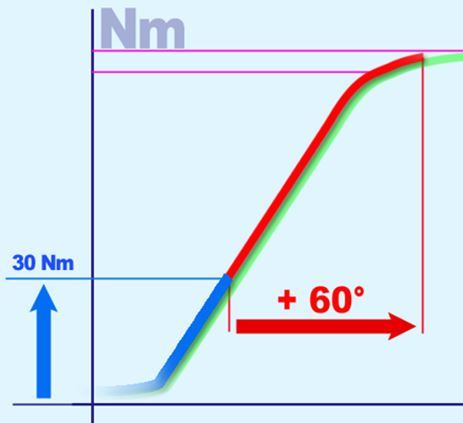Torque + Angle tightening strategy: Russian experience on the main assembly line of car producer

It is generally accepted that in the domestic automotive industry such complex tightening strategies as "Torque + Angle" are used exclusively in the engines production. Actually it is not so. Some applications can be found in the final assembly.
One more example from Russian practice
One of our customers came up with a problem: tightening the M12 x 1.5 bolts with a pneumatic angle nutrunner on a medium-soft joint, for an unknown reason began to lead to the destruction of the bolts during the tightening sequence. Checking the condition of the tool, the quality of components, the level of training of the operators did not reveal deviations. The situation was further complicated by the fact that the shutdown of the conveyor led to big losses.
Simulation of the assembly process in the laboratory showed that the reasons must be sought in the workshop. Next step was a conversation with the operators. The same question was asked: what, in their opinion, changed in the operational area or directly in the assembly process. The answer of one of the workers helped a lot: the color of the bolts changed. Previously, all bolt batches were black, and the last - with a gray finish. The bolt marking remained the same, the supplier did not change.
The result of the study puzzled everyone. It turned out that the bolt supplier had previously used phosphating, but at some point decided to replace it with a zinc coating in order to improve the anti-corrosion properties. However, the consumer was not notified. The oil mist at the workplace, created by the exhaust air of pneumatic nutrunners, with almost no effect on the phosphate coating of the bolts, formed a thin oil layer on the zinc coating, dramatically reducing the friction coefficient. It is not surprising that the new bolt was loaded more, because most of the torque was transformed into a clamping force exceeding the tensile strength of the bolt. One thing was clear: a torque adjustment or a complete replacement of the tightening strategy was required.
Simulation of the assembly process in the laboratory showed that the reasons must be sought in the workshop. Next step was a conversation with the operators. The same question was asked: what, in their opinion, changed in the operational area or directly in the assembly process. The answer of one of the workers helped a lot: the color of the bolts changed. Previously, all bolt batches were black, and the last - with a gray finish. The bolt marking remained the same, the supplier did not change.
The result of the study puzzled everyone. It turned out that the bolt supplier had previously used phosphating, but at some point decided to replace it with a zinc coating in order to improve the anti-corrosion properties. However, the consumer was not notified. The oil mist at the workplace, created by the exhaust air of pneumatic nutrunners, with almost no effect on the phosphate coating of the bolts, formed a thin oil layer on the zinc coating, dramatically reducing the friction coefficient. It is not surprising that the new bolt was loaded more, because most of the torque was transformed into a clamping force exceeding the tensile strength of the bolt. One thing was clear: a torque adjustment or a complete replacement of the tightening strategy was required.
Looking for a solution...
Laboratory tests were again needed to determine the target torque and tolerance for tightening of zinc-coated bolts with oil film. It turned out that half the initial torque value was enough to break the bolts.
Laboratory tests revealed another problem that accompanied the transition to zinc-coated bolts with different amount of oil mist: the clamping force was unstable and ranged from low to destructive.
It was not possible to determine the rated torque and the corresponding tolerance due to the large spread of the friction coefficient. The aim of the further experiment was to find a strategy that would provide sufficient clampload without breaking the bolts.
The joint behaved in such a way that to prevent displacement of parts, a minimum clamping force was required, but to ensure it, it was necessary to calculate a torque with a narrow tolerance for better repeatability and a stable amount of oil mist (!) to stabilize the friction coefficient... But the stability of the friction coefficient was the main obstacle.
Laboratory tests revealed another problem that accompanied the transition to zinc-coated bolts with different amount of oil mist: the clamping force was unstable and ranged from low to destructive.
It was not possible to determine the rated torque and the corresponding tolerance due to the large spread of the friction coefficient. The aim of the further experiment was to find a strategy that would provide sufficient clampload without breaking the bolts.
The joint behaved in such a way that to prevent displacement of parts, a minimum clamping force was required, but to ensure it, it was necessary to calculate a torque with a narrow tolerance for better repeatability and a stable amount of oil mist (!) to stabilize the friction coefficient... But the stability of the friction coefficient was the main obstacle.
Torque + Angle Strategy
There was one more decision: to test the strategy "Toque + Rotation". As a solution, this was quite suitable, but not for long, because the plant at that time was not equipped with electrical tools capable of implementing such a strategy. As a result, in order to work out the remaining 4 000 bolts and wait for a new batch (in two days), the strategy found was used as an interim solution. The bolt was tightened with a torque wrench to 15 Nm, and then turned 90 °, and the problem was completely solved. The line productivity decreased, but the line did not stop. This work really helped us convince the customer to think about investing in transducerised electrical tools. Yes, this is a costly solution, but on some operations it is quite justified, because avoids recall services or costly modifications.
The graphs below show the effect of oil mist on various coatings of bolts.
The graphs below show the effect of oil mist on various coatings of bolts.

Figure 1: Original joint with the phosphate/oil finish, torque control and the resultant clampload and variation

Figure 2: the wide variation in clampload at the same torque control, with various amounts of oil mist on the zinc plated botls

Figure 3: the relationship of angle turn and the resultant clampload
Need more information
The field of activity in which the company "Newton M", its customers, as well as products are constantly evolving. New products, service solutions, new suppliers and improvements appear almost every week.
In order to provide you with the best technical solution, prices and service, we kindly ask you to send us a message with your needs, questions or request for a commercial offer, so that we can help you in the best way and in the shortest time.
In order to provide you with the best technical solution, prices and service, we kindly ask you to send us a message with your needs, questions or request for a commercial offer, so that we can help you in the best way and in the shortest time.

Contact us
Products & Services
Additional info
Social
© Newton M LLC 2018 - 2019
12 Dzerzhinskogo St. Office 10, Togliatti
445030, Russian Federation
Phone: +7 (499) 455 1670
12 Dzerzhinskogo St. Office 10, Togliatti
445030, Russian Federation
Phone: +7 (499) 455 1670




